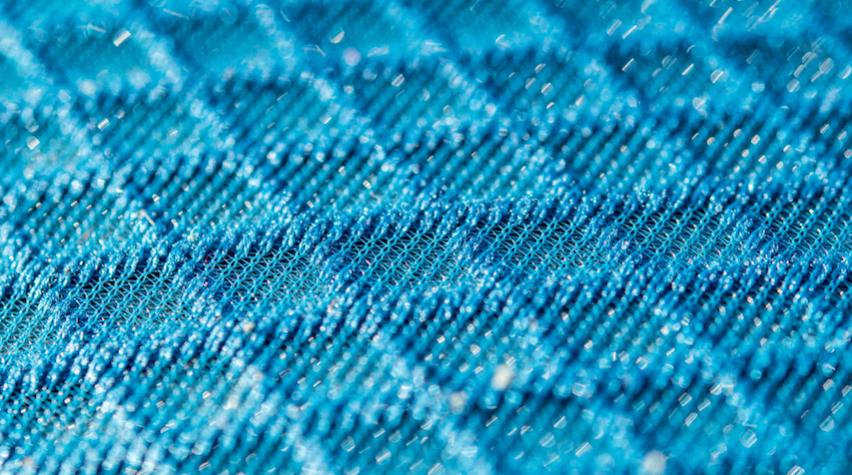
As chemical engineers, we are involved in many different industries and our work is critical to research and development (R&D) initiatives. From the development of pigments and dyes, to the scaleup that enables product affordability, the textiles and fabrics industry is no exception. The materials used in sports, outdoor, defense, and medical applications have rapidly progressed since the initial development of synthetic fibers. Ongoing research across academia and industry is backed by large-scale collaborations, such as Advanced Functional Fabrics of America (AFFOA), a member of the Manufacturing USA initiative. Here’s a look at some of the innovative clothing technology that manufacturers, designers, and bloggers forecast will shape our future.
Sustainable materials
The production and distribution of the fibers and fabrics used in the fashion industry make it the second-largest polluter of freshwater. Many apparel companies are developing products to reduce the negative environmental impacts of the industry, through either upcycling (i.e., using recycled materials), or creating longer-lasting materials or materials that degrade quickly under specific conditions.
Due to the natural abrasion that occurs as we wear and wash our clothes, plastics-derived microfibers are now so persistent in the oceans that they are found in 25% of California’s ocean-caught fish. Textile-maker Polartec, whose own innovations boosted the popularity of the fleece jacket, and PrimaLoft, a company that develops synthetic microfiber insulation, are working to combat this issue.
Polartec’s new Power Air jacket uses a multilayer, continuous-yarn fabric that encapsulates lofty fibers entirely within the material’s structure. Power Air sheds one-fifth as many microfibers as a comparable fleece while providing the same warmth. Similarly, PrimaLoft Bio is a biodegradable synthetic-fiber insulation made from 100% recycled materials. This waterproof alternative to goose or duck down degrades rapidly to reduce litter and pollution when exposed to the microbes found in landfills or oceans. In these environments, 80% of PrimaLoft Bio breaks down within one year, whereas typical synthetic fabrics can take 200 years to decompose.
Recycled content continues to be an important part of modern apparel. Through a partnership with environmental organization Parley for the Oceans, Adidas is creating a clothing line that uses only recycled plastic for the yarn. Spanish fashion brand ECOALF’s Shao sneaker is marketed as zero waste because it is made with upcycled plastic and algae.
Novel technical materials
As new materials become available, consumers have grown to expect more from their clothing. For example, features such as stretch, moisture wicking, and temperature control are standard in most basic athletic garments. But some endeavors go above and beyond these basics.
U.K.-based technical brand Vollebak has developed several products that have truly remarkable features. Their 100-Year Hoodie uses Kevlar (a strong synthetic fiber sometimes used in tires and body armor), which can survive blowtorching and other higher-than-standard levels of wear and stress. Their Graphene Jacket is a running shell that incorporates graphene, making the jacket waterproof, breathable, and durable, all while remaining lightweight.
Materials that incorporate sensors
The same sensors and electronics that have enabled self-driving cars and smartwatches are now being integrated into garments. Your clothing may one day be able to connect with your smartphone, collect biometric data, and even change color or appearance.
The Univ. of Central Florida has announced the development of Chromorphous fabric that can change color based on user input through a smartphone application. Each thread woven into the fabric incorporates a thin metal microwire. As electric currents pass through the microwires, the change in the thread’s temperature causes embedded pigments to change color.
Sensoria socks take pedometers and fitness data from smartwatches one step further. These socks contain pressure sensors that collect advanced walking and running pattern data, including cadence and foot landing technique. Designed for serious runners, they could help to identify an impending injury based on a change in running style. Another company, Omsignal, has created clothing with hidden built-in sensors that collect medical-grade data for health, wellness, worker safety, and sports.
Chemical engineers continue to have an impact on the fashion industry as we focus on sustainability, create new materials, and find ways to incorporate the latest technologies into the clothes we wear. The necessity, utility, and affordability of these items vary greatly. However, ample opportunities for engineering innovations are waiting in the vibrant world of fashion.
This article originally appeared in the Technical Entity Trends column in the February 2019 issue of CEP. Members have access online to complete issues, including a vast, searchable archive of back-issues found at aiche.org/cep.


